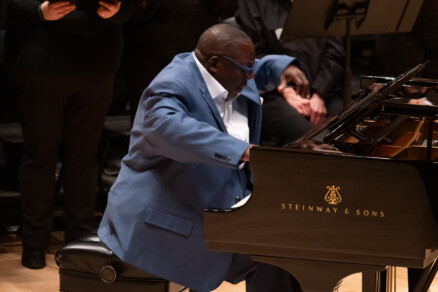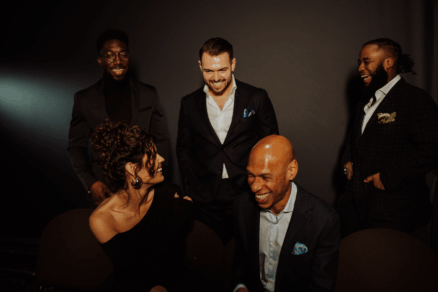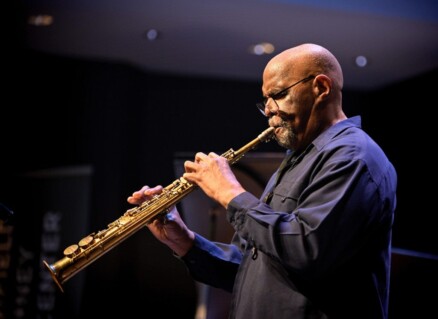Interview | The Un-temperament of Bill Cole

by Luke Stewart
Editorial board
Bill Cole has been redefining the border between jazz and world music since the early 1970s. A protégé of multi-instrumentalist Clifford Thornton, Cole began playing a variety of East Asian double-reed horns while he was a PhD candidate at Wesleyan University. In the same way Africans in America created jazz through their exposure to Western instruments, Cole is creating a new language in jazz through his use of East Asian instruments.
Endowed with the legacy of jazz artists such as Yusef Lateef, Ken McIntyre and many others using such instruments, Cole decided in 1992 to incorporate these sounds into his Untempered Ensemble. The group began as a trio but has expanded and contracted in size over the years, at various points including major avant-garde figures such as William Parker and Cooper-Moore.
I was honored to interview Mr. Cole ahead in advance of his performance at Bohemian Caverns, which will take place this Sunday as part of Transparent Productions’ Sundays at Seven at the Caverns series.
CapitalBop: Could you introduce our readers to the Untempered Ensemble?
Bill Cole: The members of the ensemble are Warren Smith on percussion, Joe Daley on euphonium and tuba, Ras Moshe on tenor saxophone and flute, Atticus Cole on hand drums, Shayna Dulberger on the bass, Althea Sully Cole on voice and kora and myself on double reed horns, which come from Asia.
CB: And what are the instruments that you play in this ensemble?
BC: I play the Chinese suona; I play the Indian shenai and nagaswaram; I play the Korean piri and hojok; I play a West African Ghanaian flute. Also, I play the didgeridoo [of indigenous Australian origin].
CB: How did you come to play these non-Western-traditional instruments?
BC: I was doing my PhD work at Wesleyan University in Middletown, Conn., and I studied with Clifford Thornton. He played the valve trombone, trumpet, flugelhorn and also the Indian shenai, which I now play. He gave me two instruments; one was the Chinese sona and the other was the Korean hojok. Both are folk instruments. He told me to learn how to play them.
I was immediately intrigued by the sound of the instruments. After a while, I would go over to his apartment, because he wouldn’t even tell me the instruments needed a reed. It was something I had to find out for myself. So I used to listen to him practicing the shenai and from listening to him, I could tell the vertical level of the instrument – you know, from top to bottom, how high it can go and how low it can go. I began to work on them, study them, practice on them, and manage to get pretty good facility on the instruments. This was in 1972.
Then I purchased a shenai. Later, I purchased an East Indian instrument called the nagaswaram. Then my partner Warren Smith went to South Korea and I asked him to bring me back an instrument. He brought me back a piri. I also [started to] play two different sizes of the Chinese suona, and I wanted to learn how to cycle-breathe. Some years ago – I would say maybe in the 1970s or early ’80s – I played a concert in Albuquerque, N.M. Afterwards, they gave a reception, and a gentleman at the reception said to me that he had an instrument that he thought I could learn how to play. So he went home and came back with a very small didgeridoo from the Philippines made out of bamboo. [Playing the didgeridoo requires that the performer be able to cycle-breathe.]
“My thought was, “Why do people play saxophones, or trumpets, or trombones, or pianos, or bass?” There is something about the sound that comes from these different instruments which intrigues the individuals who have learned to play them. That’s the same way with me.”
Then years later, I used to send away for articles and different things that I saw of notifications of people who could show me how to cycle-breathe. I wasn’t successful from these little cards that people would send me. Then there’s this thing called the Open Center in New York City, and there was a gentleman there teaching people how to play the didgeridoo. And I said, “Oh good, I’m gonna sign up for this class and I’m quite certain I’ll learn how to cycle-breathe.” And I did. I wasn’t that interested in playing the didgeridoo at that time, but I was interested in learning how to cycle-breathe, because I wanted to use that on the other instruments that I play….
CB: In terms of your musical development, when did you come to play these instruments? What was your first instrument?
BC: I played the piano for a long, long time. But strangely enough, it was an instrument that I couldn’t hear. I would listen to people like Red Garland and Bud Powell and I couldn’t figure out what they were doing! Especially Red Garland really confounded me with his block chords. I just realized that this wasn’t the instrument for me. I played cello for a while, which I loved. But what happened was, I lost my job, I had to sell my cello, I had to stop taking cello lessons, and so I kind of moved away from that. I never really could, what I consider, “play” an instrument. I could play Chopin’s Preludes on the piano, but I couldn’t improvise on them. There was something about the instrument that didn’t … I can’t explain it. I’ve never had a piano player in my group, and I’ve had the Untempered Ensemble since 1992 when I first formed it….
So when I got these instruments from Clifford, I just loved the sound of them so much that I began studying them and practicing, and I got to the point where I was practicing eight hours a day. I’ve never really been able to explain logically, and everybody asks me the same question: “Why do you play these instruments?” I guess my thought was, “Why do people play saxophones, or trumpets, or trombones, or pianos, or bass?” There is something about the sound that comes from these different instruments which intrigues the individuals who have learned to play them. That’s the same way with me.These instruments that I play, the sounds that comes from the instruments, just were very intriguing to me, and I had to learn how to play them.

CB: How were those sounds exposed to you?
BC: Well, I first heard Clifford play the shenai. Then he turned me on to some East Indian shenai players. I guess the most famous one was a gentleman named Bismillah Khan. I don’t know if he is still alive, but he was a tremendous player. He had a whole group of shenai players, most of whom were his relatives, in his ensemble. He was the first person I really listened to intensely to learn how to play the instrument. But also there were other individuals. For instance, Dewey Redman played the suona. It wasn’t his primary instrument, but he did play it. There were other artists who played these instruments. Roland Kirk played some instruments that were very similar to the instruments that I play. So I’m not that unique.
CB: Leading up to your PhD, were you studying the piano and cello while completing your bachelor’s and master’s degrees?
BC: No, because my first two degrees were at the University of Pittsburgh, and they didn’t require that you play an instrument. I studied there for my first six years; until I got my master’s, it was all in Western art music. The study of the history, the theory and composition, etc. It wasn’t until I was in my second year of my master’s program there that they hired Nathan Davis, who is a gentleman that plays the saxophone and flute, as an assistant professor. He was the first Black professor that they had at the music department at the University of Pittsburgh. It was through him that I was able to write my master’s thesis about Miles Davis, which eventually turned into a book.
“John Coltrane was just an amazing player…. It was just that he had this tremendous facility, but he never left this feeling of coming from the ‘folks.’”
CB: So you got your master’s and bachelor’s in ethnomusicology?
BC: I got my master’s and my bachelor’s in musicology, because at that time they had no ethnomusicologists there. It was all the study of Western art music. In fact, before Nathan Davis came to the music department of the University of Pittsburgh, I was gonna write my master’s thesis on the quintets of Mozart. So he was a real wellspring for me. Because I loved Miles Davis’ music from when I was a kid.
CB: You’ve written about Miles Davis, John Coltrane and Eric Dolphy. How have these masters influenced you and your music?
BC: I first saw John Coltrane in 1955, when he was in Miles Davis’ Quintet. The quintet was Paul Chambers and Red Garland, Philly Joe Jones, Miles and Trane. I knew his music so well that I could sing all of Paul Chambers’ lines, and I knew all of Miles Davis’ improvisations. When I started to really study Miles Davis in depth – because when you are just a general listener, you are not really studying the individual in depth and trying to figure out what he is doing and why he is such an influential and important figure in the music – I realized that John Coltrane was just an amazing player…. It was just that he had this tremendous facility, but he never left this feeling of coming from the “folks.” When you listen to his tone and the sound he had on his instrument, he always had that Philadelphia feeling when he played, that High Point, N.C. feeling that he played with in his music. I wanted to find out why that was, why he was just so in tuned with his own essence. Players are always listening to other players and picking up stuff, but he was so unique.
Then the idea that you can look at musicians that come along in all different eras that this music has created, and you will not find too many players who have mastered one tradition and vanguarded a new tradition like John Coltrane did. John Coltrane mastered the hard-bop tradition. And in terms of playing free music, going beyond what the saxophone was made to play, he mastered that also. He was a very unique artist in terms of his own personal creativity, and he was a musician that I saw numerous times play. I can’t even count the number of times I heard him play. I saw his first quartet that had Steve Davis as the bass player. Then later on, Reggie Workman was in the band, then Art Davis, then Jimmy Garrison. At the time Trane lived, the music he was playing that was recorded commercially and put forth for people to buy was not the music he was playing in the clubs live. He was playing a type of music that was totally different from that. It has only been since he died that some of that music has begun to come out.
That really strong, ongoing, never-ending voice that he had on the instruments, all those things intrigued me. Plus, he was in Miles Davis’ band. Miles didn’t give him his first shot, but gave him his first national and international notice as an artist. Miles Davis, of course, was a tremendous innovator and player and always had fantastic people in his groups. So the two of them were a wonderful combination because they were the opposite in personality.
CB: So how does all of this inform your musical concept in the Untempered Ensemble?
BC: Being able to play music is a tremendous gift. I’ve always felt that because of that, I want to always be giving everything I can in playing the music, and never compromising myself as a musician. No matter what people say about me or what they write about me or what other musicians say about me, I never really wanted to compromise myself as a musician, because I just want to play the music that is inside me.
As I began to become fluent in the instruments that I play, I began to realize how much beauty was inside me to play, so I decided that I must have musicians that are compatible in my ensemble. Warren Smith is a tremendous percussionist. When you look at his history and the numbers of people he has played with, he has played in every genre you can think of – from Broadway musicals to Aretha Franklin to Nina Simone to Janis Joplin to Barbara Streisand. He’s so experienced as an artist. He and I have been playing together now for almost 40 years. He senses where I’m coming from.
Then there’s Joe Daley. He and Warren were in my original ensemble. My original ensemble was just a trio, and I began to expand it and brought in Cooper-Moore, then William Parker, then my son Atticus, who is a hand drummer, then Sam Furnace, who died in 2004. All those individuals are tuned into their own personal artistry and they brought that kind of energy to my ensemble. I have always appreciated the people I’ve played with. I’ve played with Julius Hemphill and Sam Rivers and Jerry Gonzalez, and so many different people. So it is just a tremendous love that I have and my inability to ever compromise my music because it is such an important aspect of my life. And I have reverence to the people who have come before me and have made contributions to this music.
CB: Is there anything in particular that excites you about coming to D.C.?
BC: I’ve played several times in Bobby Hill’s Transparent Productions performances. This will be my fourth or fifth time. I’ve played with different sizes of groups. I’ve played with trios, quartets and I played with my total ensemble when he had his venue in Takoma Park, Md. He told me one time that more people showed up for that event than any event that he had had previously. I think that in some way my music is accessible to people, and to people in Washington, D.C.
My uncle used to live in Washington, and I used to go down to visit him in the summer, usually for a couple of weeks. In the early 1900s, he was a musician. He played the banjo and sang. He would talk to me about music and what it was like for him as a musician in the early 1900s. In fact, the place we are playing on Sunday [Bohemian Caverns], I first heard music there in my 20s. If I recall clearly, the person I went to see was Miles Davis.
—
Bill Cole performs at Bohemian Caverns on Sunday as part of Transparent Productions’ “Sundays at 7 at the Caverns” series. Find more info here, and buy tickets here.
Bill Cole, Bohemian Caverns, DC, DC jazz, didgeridoo, double reeds, hojok, jazz, John Coltrane, Miles Davis, nagaswaram, piri, shenai, suona, U Street, Untempered Ensemble, Washington




